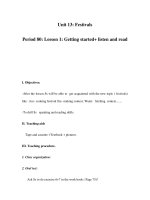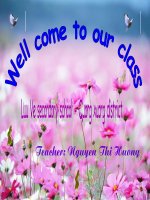Unit 11 Our greener world Lesson 1 Getting started
Bạn đang xem bản rút gọn của tài liệu. Xem và tải ngay bản đầy đủ của tài liệu tại đây (1.29 MB, 16 trang )
<span class='text_page_counter'>(1)</span>Friday, March, 17th 2017. Teacher: Tran Hong Anh.
<span class='text_page_counter'>(2)</span> Which day is the World Environment Day? On 5 June.
<span class='text_page_counter'>(3)</span> UNIT 11: OUR GREENER WORLD LESSON 1: GETTING STARTED.
<span class='text_page_counter'>(4)</span>
<span class='text_page_counter'>(5)</span> reusable natural materials. green air pollution.
<span class='text_page_counter'>(6)</span> a, Read the conversation again and complete the following sentences.. 1, Nick is going _____________ on the picnic tomorrow. 2, The green shopping bag is__________ reusable . The materials of the bag are _________ natural 3, People can buy the bag at the check-out 4, Mi wants to buy__________ a reusable bag for her mum. cycling 5, Nick thinks that Mi’s ‘green’ because she is____________..
<span class='text_page_counter'>(7)</span> b, Based on the ideas in the conversation, match the first half…..
<span class='text_page_counter'>(8)</span> NOTES: 2. There will be less air pollution if more people cycle.. S. V. O. S. 3. If people use reusable bags for shopping, they will help the environment.. V O This is a type of conditional sentences: type 1:. If S + V + O, S + will/won’t + V + O. Use: it’s a real condition which be used to describe the actions might happen in the future. Example:. If I have money, I will buy a new house..
<span class='text_page_counter'>(9)</span> c) Find these expressions in the conversation. Check what they mean: 1. I see 2. By the way. 3. Not at all.
<span class='text_page_counter'>(10)</span> I see = I understand. By the way = Used to introduce a new subject for consideration or to give further information. Not at all = Used to say “no” or “not” strongly (can also be used to mean “no problem”)..
<span class='text_page_counter'>(11)</span> d) Fill each blank with a suitable conversation: 1. A: It works like this. B: Oh, I see 2. A: Are you tired? B: Not at all 3. A: What are you going to do this weekend? B: I’m going to a birthday party. By the way, What do you think about this dress?.
<span class='text_page_counter'>(12)</span> 2. Write each problem in the box under the picture: air pollution. water pollution. noise pollution. 2.. 1.. 4.. deforestation. soil pollution. 3.. 5..
<span class='text_page_counter'>(13)</span>
<span class='text_page_counter'>(14)</span> 5, Match the causes in column A with the effects in column B.
<span class='text_page_counter'>(15)</span> • STRUCTURES: conditional sentence type 1 to make sth/sb do sth. to cause sth.. • Talk about environmental problems’ effects..
<span class='text_page_counter'>(16)</span> - Choose one environmental problem and write as many effects of the problem as possible. - Prepare lesson 2: A closer look 1..
<span class='text_page_counter'>(17)</span>









